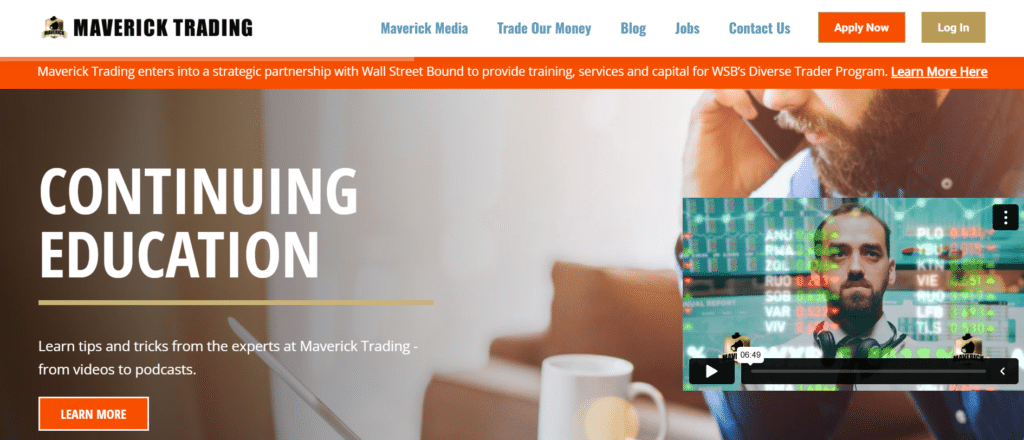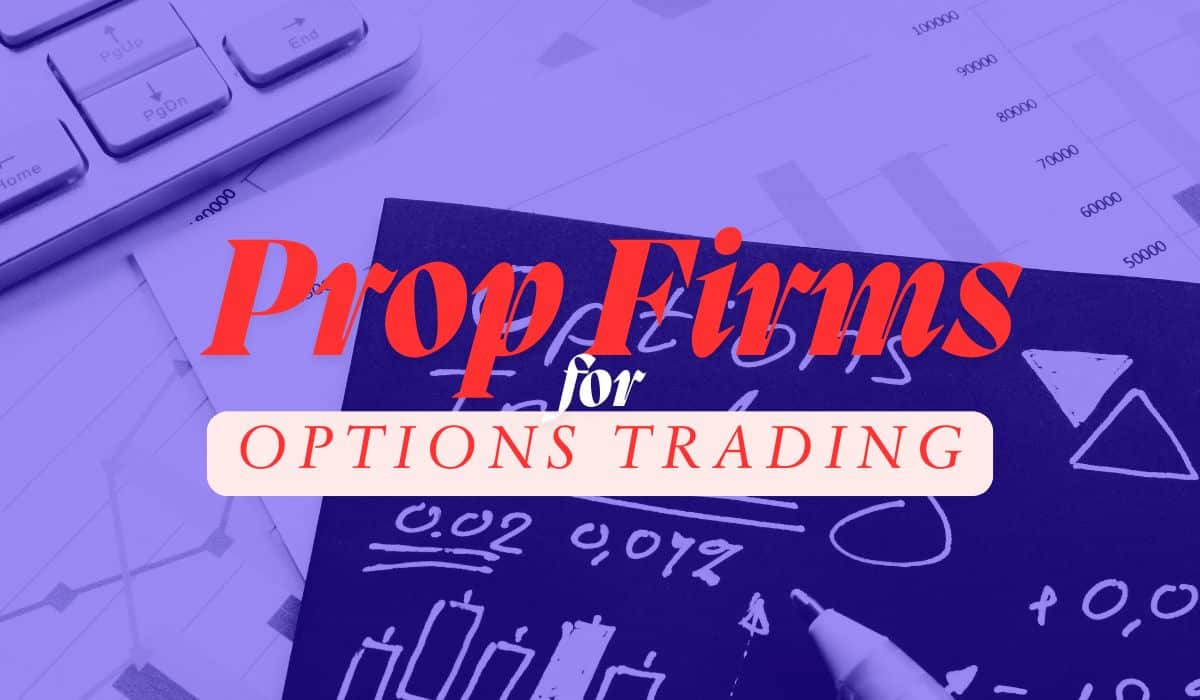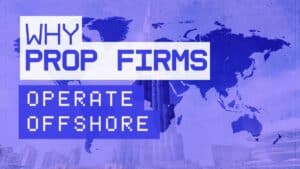What Are Options Prop Firms and Why Are They So Rare?
An options prop firm is a company that gives traders money to trade options, and then takes a cut of the profits. Sounds simple.
New to this whole prop firm thing? This 101 guide breaks down how prop firms actually work and what separates legit ones from MLM-style trash.
But if you’re wondering why there aren’t a ton of them, here’s the short version: options are a pain in the ass.
Now let’s compare. Forex and futures prop firms (like FTMO and Topstep) let you take a test. Don’t lose too much money, follow the rules, and boom—you’re funded.
That model works because forex and futures are easier to manage. Risk is predictable. The math is clean.
Options? Total mess.
- The price changes if time passes.
- The price changes if volatility moves.
- The price changes if your broker sneezes weird.
And worst of all: you can lose more than you started with. Not just your money—the firm’s money.
So most firms look at options and say: “Nah, we’re good.”
That’s why only a few real ones exist. Maverick Trading is one. You go through training, post a bond, and trade real capital. T3 Trading Group is another, but they lean more old-school and might need a license.
Most firms stick to forex or futures because launching an options firm is a different beast entirely — the risk, the tech, the oversight. If you ever wondered what actually goes into starting a prop firm, this breakdown pulls the curtain back.
Options prop firms are real. Just rare. Because handling options risk is like babysitting a tiger: doable, but only if you know what you’re doing.
Are There Prop Firms for Options Trading?
Yes, there are. But only a few like Maverick Trading and T3 Trading Group actually fund traders for options.
Most prop firms don’t offer it. Why? Options are complicated, risky, and hard to manage.
- The margin rules are way more complex than forex or futures.
- Risk changes fast. One trade can go sideways in five minutes.
- Simulated options trading? Almost impossible to get right.
So it’s not that firms can’t offer options—it’s that they’d rather wrestle a cactus.
But if you’re not scared off by a bit of paperwork and a $5K bond, Maverick is the real deal. You apply, train, pass the sniff test, and trade with firm capital. T3 Trading Group does it too—though it’s more “Wall Street intern energy”.
If you’re looking for a quick challenge, this ain’t it. But if you want real options capital and a long-term path, these are your best bets.
Best Prop Firms for Options Trading in 2025
| Firm | Assets | Capital Access | Training | Remote? | Highlight Feature |
| Maverick | Options, FX | $25K to $500K+ | ✅ Deep, structured | ✅ | Refundable fee, 70/30 split |
| SMB Capital | Equities, Options | Performance-based | ✅ In-depth | ❌ NYC | Institutional access |
| T3 Trading | Equities, Options | Varies | ✅ Moderate | ✅ | Licensing support (SIE/57) |
Callout: If you’re a retail trader looking to go pro in options, Maverick is the easiest door to walk through. Structured, remote, and you don’t need a license to start.
How to Join an Options Prop Firm – Maverick vs. T3 Side-by-Side
Not all options prop firms roll out the red carpet—some barely offer a doormat.
Here’s a side-by-side of the only two that won’t waste your time. If you’re serious about getting funded, this is how the gatekeeping actually works.
Maverick Trading – Onboarding Process

Step 1: Read the Basic FAQ
Covers how you’re paid (profit split), what kind of contract you’re signing (1099), and confirms they’re not a broker.
Step 2: Complete the Trader Profile
You’ll list your trading experience, licenses (if any), and how much capital you’ve traded before.
Step 3: Watch the Intro Video
Roughly 10 minutes breaking down the Maverick model, capital sharing, and how funding works.
Step 4: Review the Advanced FAQs
Dives deeper into risk rules, payouts, and scaling.
Step 5: Schedule an Interview
Confirm your phone number, pick a time, and expect a call from a recruiter.
✅ Maverick Highlights
- No experience required to apply
- 100% remote-friendly
- $7K refundable training fee (if you pass and perform)
- $5K performance bond unlocks real capital
T3 Trading Group – Onboarding Process

Step 1: Confirm U.S. Residency
Required for their main licensed track. (There is a non-U.S. path, but it’s limited.)
Step 2: Prove Experience
You need a track record. This isn’t for beginners.
Step 3: Licensing
SIE and Series 57 preferred—but they’ll sponsor you if you’re accepted and serious.
Step 4: Choose Your Track
Licensed traders get full access. Non-licensed traders may face restrictions.
Step 5: Interview and Compliance
Expect a review process and some paperwork—it’s more institutional.
✅ T3 Highlights
- Experience required
- Licensing preferred (sponsorship available)
- U.S.-centric setup (with some flexibility)
- Heavier focus on professional-level trading
📌 Quick Take:
If you’re just starting out or want remote flexibility, Maverick is more accessible.
If you’re licensed, proven, and U.S.-based, T3 offers a more institutional path.
Why Most Options Prop Firms Don’t Exist
Most prop firms treat options like a cursed artifact. Fascinating, but absolutely not worth the risk of touching.
- Options risk is complex. It’s not just “up or down.” You’re managing Greeks (like delta, theta, vega), volatility shifts, and time decay. Every second changes the risk.
- Losses can be unlimited. Sell the wrong naked option and you could owe more than you made last year. That’s a lot of risk for a firm to carry on your behalf.
- Regulations are a nightmare. U.S.-based options firms have to answer to FINRA and the SEC. That means licenses, compliance teams, and tight surveillance.
- Tech costs are higher. Forex prop firms run MetaTrader on a shoestring. Options firms need custom platforms, real-time risk engines, and data feeds that don’t come cheap. Thinking of building your own? Here’s how to start a prop firm on a budget—just don’t expect it to be easy if you’re tackling options.
So no, it’s not because firms hate options. It’s just that the risk, red tape, and tech bills make most of them say: “No thanks, we’ll stick to forex.”
Can You Trade Options on FTMO or Similar Firms?
No, you can’t trade options on FTMO. Or Topstep. Or any of the major forex-style challenge firms.
Here’s why:
- Their platforms (like MetaTrader 4/5) don’t support options contracts. They’re built for forex pairs, CFDs, and commodities—not multi-leg spreads or IV crushes.
- Options require specialized platforms like Tastyworks, Thinkorswim, or Interactive Brokers—none of which are used by challenge-style prop firms.
If you want to trade options with firm capital, you’ll need to look at firms that were built for that. Right now, Maverick Trading and T3 are your main options—pun fully intended.
What to Expect When Joining an Options Prop Firm
Options prop firms don’t just hand you $100K because you know what a put is. They want proof you can trade without lighting their capital on fire. Here’s what getting in usually looks like:
- Application
You’ll fill out a form with your background, trading experience, and capital exposure. Be real—they actually read it. - Interview
Most legit firms (like Maverick) set up a call. They’re investing in you, not just selling a PDF course. - Trial or Training Period
Expect to complete some kind of evaluation—could be demo trading, a written test, or watching educational modules. - Performance Bond or Payment
You may need to post money up front (usually $2K–$7K). This isn’t a fee you lose—it’s often refundable if you trade well. - Account Funding
Once approved, you get real capital (often $25K+). Your access grows with consistency and performance. - Profit Splits
Typical split is around 70/30—trader keeps 70%, firm takes 30%. Some offer higher if you scale. - Payout Timelines
Most pay monthly. Maverick, for example, processes payouts after options expiration each month. - Drawdown Rules & Risk Caps
Expect daily and total loss limits. If a firm doesn’t give you these? That’s a red flag.
This isn’t a quick-hit scheme—it’s a serious setup. And real prop firms treat it like a business.
What to Watch Out For (Red Flags & Pitfalls)
Not all prop firms are built the same. Some are more “sell a dream” than “fund a trader.” Here’s what to keep your radar on:
- Hidden Fees
If the pricing only shows up after you’ve applied or emailed them, that’s a bad sign. - Mandatory Upsells
Some firms force you into $1,000 psychology courses or extra software you didn’t ask for. That’s not support—it’s upselling. - Vague Profit Split Terms
If they can’t clearly explain how you get paid and when, walk away. “Trust us” is not a payout plan. - No Stop-Loss or Risk Rules
Firms that don’t mention drawdowns or risk caps are either clueless or reckless. Either way, you don’t want their money. Also, some firms weaponize ‘consistency rules’ as a payout trap. Know the difference between discipline and BS.
Bottom line: a good options prop firm is clear, structured, and accountable. Anything else is a sales funnel with charts.
Final Verdict – Are Options Prop Firms Worth It?
Yes—if you know what you’re doing and want access to serious capital.
No—if you’re chasing an easy, no-risk side hustle. This isn’t passive income. It’s active risk, real rules, and real money on the line.
Who Each Firm Is Best For
| Firm | Best For |
| Maverick | Traders who want a structured program, mentorship, and remote funding. |
| T3 Trading | Experienced U.S. traders aiming for institutional-level access and are willing to get licensed. |
📌 Callout:
If you’re serious about building a career with options, these firms can put serious capital behind you. Just know—there’s no shortcuts, no sugarcoating, and no free rides.
Before You Commit
- Options prop firms are rare. That alone should tell you they’re not plug-and-play.
- Do your homework. Understand the fees, the rules, and the payout terms before signing anything.
- Compare what matters:
- How much capital do they fund?
- Are there stop-loss limits or drawdown rules?
- Is training legit or just a sales funnel?
- How much capital do they fund?
If you’re the kind of trader who takes this seriously, there’s opportunity here. You either come in sharp, or you leave broke and confused, like “what happened to my rent money?”
The game’s real. The market don’t love you. And Maverick is not your mama.
Here is a good video is you want to learn more about options:
Author
-
Alex started his career creating travel content for Jalan2.com, an Indonesian tourism forum. He later worked as a web search evaluator for Microsoft Bing and Google, where he spent over a decade analyzing search relevance and understanding how algorithms interpret content. After the pandemic disrupted online evaluation work in 2020, he shifted to freelance copywriting and gradually moved into SEO. He currently focuses on content strategy and SEO for finance and trading-related websites.
Recent Posts






